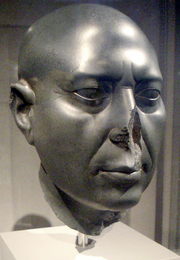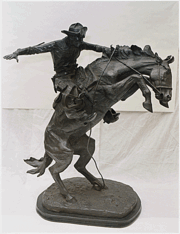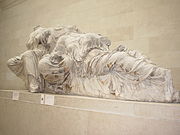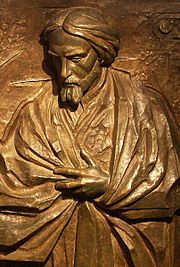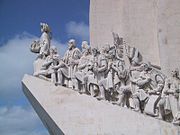
Sculpture
Did you know...
Arranging a Wikipedia selection for schools in the developing world without internet was an initiative by SOS Children. A good way to help other children is by sponsoring a child


Sculpture is three-dimensional artwork created by shaping or combining hard materials - typically stone - or marble, metal, glass, or wood. Softer ("plastic") materials can also be used, such as clay, textiles, plastics, polymers and softer metals.
The term has been extended to works including sound, text and light.
Found objects may be presented as sculptures. Materials may be worked by removal such as carving; or they may be assembled such as by welding , hardened such as by firing, or molded or cast. Surface decoration such as paint may be applied. Sculpture has been described as one of the plastic arts because it can involve the use of materials that can be moulded or modulated.
Sculpture is an important form of public art. A collection of sculpture in a garden setting may be referred to as a sculpture garden.
Types of sculpture
Some common forms of sculpture are:
- Free-standing sculpture, sculpture that is surrounded on all sides, except the base, by space. It is also known as sculpture "in the round", and is meant to be viewed from any angle.
- Sound sculpture
- Light sculpture
- Jewellery or Jewelry
- Relief - the sculpture is still attached to a background; types are bas-relief, alto-relievo, and sunken-relief
- Site-specific art
- Kinetic sculpture - involves aspects of physical motion
- Fountain - the sculpture is designed with moving water
- Mobile (see also Calder's Stabiles.)
- Statue - representationalist sculpture depicting a specific entity, usually a person, event, animal or object
- Bust - representation of a person from the chest up
- Equestrian statue - typically showing a significant person on horseback
- Stacked art - a form of sculpture formed by assembling objects and 'stacking' them
- Architectural sculpture
- Environmental art
- Environmental sculpture
- Land art
Materials of sculpture through history
The materials used in sculpture are diverse, changing throughout history. Sculptors have generally sought to produce works of art that are as permanent as possible, working in durable and frequently expensive materials such as bronze

and stone: marble, limestone, porphyry, and granite. More rarely, precious materials such as gold, silver, jade, and ivory were used for chryselephantine works. More common and less expensive materials were used for sculpture for wider consumption, including glass, hardwoods (such as oak, box/boxwood, and lime/linden); terracotta and other ceramics, and cast metals such as pewter and zinc (spelter).
Sculptures are often painted, but commonly lose their paint to time, or restorers. Many different painting techniques have been used in making sculpture, including tempera, [oil painting], gilding, house paint, aerosol, enamel and sandblasting.
Many sculptors seek new ways and materials to make art. Jim Gary used stained glass and automobile parts, tools, machine parts, and hardware. One of Pablo Picasso's most famous sculptures included bicycle parts. Alexander Calder and other modernists made spectacular use of painted steel. Since the 1960s, acrylics and other plastics have been used as well. Andy Goldsworthy makes his unusually ephemeral sculptures from almost entirely natural materials in natural settings. Some sculpture, such as ice sculpture, sand sculpture, and gas sculpture, is deliberately short-lived.
Sculptors often build small preliminary works called maquettes of ephemeral materials such as plaster of Paris, wax, clay, or plasticine, as Alfred Gilbert did for 'Eros' at Piccadilly Circus, London. In Retroarchaeology, these materials are generally the end product.
Sculptors sometimes use found objects.
Asian
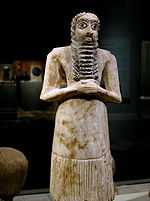
Many different forms of sculpture were used in Asia, with many pieces being religious art based on Hinduism and Buddhism (Buddhist art) and greco-Buddhist art. A great deal of Cambodian Hindu sculpture is preserved at Angkor, however organized looting has had a heavy impact on many sites around the country. In Thailand, sculpture was almost exclusively of Buddha images. Many Thai sculptures or temples are gilded, and on occasion enriched with inlays. See also Thai art
East Asia
China
Artifacts from China date back as early as 10,000 BC and skilled Chinese artisans had been active very early in history, but the bulk of what is displayed as sculpture comes from a few select historical periods. The first period of interest has been the Western Zhou Dynasty (1050-771 BC), from which come a variety of intricate cast bronze vessels. The next period of interest was the Han Dynasty (206 BC-220 AD), beginning with the spectacular Terracotta Army assembled for the tomb of Qin Shi Huang, the first emperor of the important but short-lived Qin Dynasty that preceded the Han. Tombs excavated from the Han period have revealed many figures found to be vigorous, direct, and appealing 2000 years later.
The first Buddhist sculpture is found dating from the Three Kingdoms period (3rd century), while the sculpture of the Longmen Grottoes near Luoyang, Henan Province ( Northern Wei, 5th and 6th century) has been widely recognized for its special elegant qualities.

The period now considered to be China's golden age is the Tang Dynasty, coinciding with what in Europe is sometimes called the Dark Ages). Decorative figures like those shown below became very popular in 20th century Euro-American culture, and were made available in bulk, as warlords in the Chinese civil wars exported them to raise cash. Considered especially desirable, and even profound, was the Buddhist sculpture, often monumental, begun in the Sui Dynasty, inspired by the Greco-Buddhist art of Central Asia, and many are considered treasures of world art.
Following the Tang, Western interest in Chinese artifacts drops off dramatically, except for what might be considered as ornamental furnishings, and especially objects in jade. Pottery from many periods has been collected, and again the Tang period stands out apart for its free, easy feeling. Chinese sculpture has no nudes—other perhaps than figures made for medical training or practice—and very little portraiture compared with the European tradition. One place where sculptural portraiture was pursued, however, was in the monasteries.
Almost nothing, other than jewelry, jade, or pottery is collected by art museums after the Ming Dynasty ended in the late 17th century—and absolutely nothing has yet been recognized as sculpture from the tumultuous 20th century, although there was a school of Soviet-influenced social realist sculpture in the early decades of the Communist regime, and as the century turned, Chinese craftsmen began to dominate commercial sculpture genres (the collector plates, figurines, toys, etc.) and avant garde Chinese artists began to participate in the Euro-American enterprise of contemporary art.
-
Calvalryman, Qin Dynasty
-
Terracotta Army soldier and horse from the Qin Dynasty
-
Tang Dynasty rider (618-907)
-
Tang Dynasty girl figurine (618-907)
-
Boddisatva, Tang Dynasty (618-907)
-
Seated Buddha, Tang Dynasty ca. 650.
-
The Leshan Giant Buddha, Tang Dynasty, completed in 803.
-
Portrait of monk, Song Dynasty, 11th century
-
A wooden Bodhisattva from the Song Dynasty (960-1279)
-
A glazed stoneware statue, Ming Dynasty (16th century)
-
Statue of Guanyin, by Chaozhong He, Ming Dynasty (1368-1644)
-
Blue underglaze statue of a man with his pipe, from Jingdezhen, Ming Dynasty (1368-1644)
Japan
Countless paintings and sculptures were made, often under governmental sponsorship. Most Japanese sculpture is associated with religion, and the medium' use declined with the lessening importance of traditional Buddhism. During the Kofun period of the third century, clay sculptures called haniwa were erected outside tombs. Inside the Kondo at Hōryū-ji is a Shaka Trinity (623), the historical Buddha flanked by two bodhisattvas and also the Guardian Kings of the Four Directions. The wooden image ( 9th c.) of Shakyamuni, the "historic" Buddha, enshrined in a secondary building at the Murō-ji, is typical of the early Heian sculpture, with its ponderous body, covered by thick drapery folds carved in the hompa-shiki (rolling-wave) style, and its austere, withdrawn facial expression. The Kei school of sculptors, particularly Unkei, created a new, more realistic style of sculpture.
Central Asia
Greco-Buddhist art is the artistic manifestation of Greco-Buddhism, a cultural syncretism between the Classical Greek culture and Buddhism, which developed over a period of close to 1000 years in Central Asia, between the conquests of Alexander the Great in the 4th century BCE, and the Islamic conquests of the 7th century CE. Greco-Buddhist art is characterized by the strong idealistic realism of Hellenistic art and the first representations of the Buddha in human form, which have helped define the artistic (and particularly, sculptural) canon for Buddhist art throughout the Asian continent up to the present. It is also a strong example of cultural syncretism between eastern and western traditions.
The origins of Greco-Buddhist art are to be found in the Hellenistic Greco-Bactrian kingdom (250 BCE- 130 BCE), located in today’s Afghanistan, from which Hellenistic culture radiated into the Indian subcontinent with the establishment of the Indo-Greek kingdom (180 BCE-10 BCE). Under the Indo-Greeks and then the Kushans, the interaction of Greek and Buddhist culture flourished in the area of Gandhara, in today’s northern Pakistan, before spreading further into India, influencing the art of Mathura, and then the Hindu art of the Gupta empire, which was to extend to the rest of South-East Asia. The influence of Greco-Buddhist art also spread northward towards Central Asia, strongly affecting the art of the Tarim Basin, and ultimately the arts of China, Korea, and Japan.
-
Fragment of the wind god Boreas, Hadda, Afghanistan.
-
The Buddha, flanked by Herakles/ Vajrapani and Tyche/ Hariti.
South Asia
India
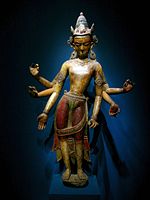
The first known sculptures are from the Indus Valley civilization (3300–1700 BC), found in sites at Mohenjo-daro and Harappa in modern-day Pakistan. Later, as Hinduism, Buddhism, and Jainism developed further, India produced bronzes and stone carvings of great intricacy, such as the famous temple carvings which adorn various Hindu, Jain and Buddhist shrines. Some of these, such as the cave temples of Ellora and Ajanta, are examples of Indian rock-cut architecture, perhaps the largest and most ambitious sculptural schemes in the world.
The pink sandstone sculptures of Mathura evolved during the Gupta Empire period (4th-6th century AD) to reach a very high fineness of execution and delicacy in the modeling. Gupta period art would later influence Chinese styles during the Sui dynasty, and the artistic styles across the rest of east Asia. Newer sculptures in Afghanistan, in stucco, schist or clay, display very strong blending of Indian post-Gupta mannerism and Classical influence. The celebrated bronzes of the Chola dynasty (c. 850-1250) from south India are of particular note; the iconic figure of Nataraja being the classic example. The traditions of Indian sculpture continue into the 20th and 21st centuries with for instance, the granite carving of Mahabalipuram derived from the Pallava dynasty. Contemporary Indian sculpture is typically polymorphous but includes celebrated figures such as Dhruva Mistry.
Africa
African art has an emphasis on Sculpture - African artists tend to favour three-dimensional artworks over two-dimensional works.
African sculptures
The style, key aesthetic characteristics, materials, and techniques used in the creation of a piece of sculpture reflects the region from which it originates. Sculptures often have unique functions that vary widely from one geographical region to the next.
In West Africa, the earliest known sculptures are from the Nok culture of Nigeria, which dates around 500 BC. The figures of West African sculptures typically have elongated bodies, angular shapes, and facial features that represent an ideal rather than an individual. These figures are used in religious rituals. They are made to have surfaces that are often coated with materials placed on them for ceremonial offerings. In contrast to these sculptures of West Africa are the ones of Mande-speaking peoples of the same region. The Mande pieces are made of wood and have broad, flat surfaces. Their arms and legs are shaped like cylinders.
In Central Africa, however, the main distinguishing characteristics include heart-shaped faces that are curved inward and display patterns of circles and dots. Although some groups prefer more geometric and angular facial forms, not all pieces are exactly the same, nor are they made of the same material. The primary material is wood, though ivory, bone, stone, clay, and metal are also used. The Central African region has very striking styles that are very easy to identify, making regional identification very easy.
Eastern Africans are not known for their sculpture, but, one type that is created in this area is pole sculptures, which are poles carved in human shapes, decorated with geometric forms, while the tops are carved with figures of animals, people, and various objects. These poles are, then, placed next to graves and are associated with death and the ancestral world.
Southern Africa’s oldest known clay figures date from 400 to 600 A.D. and have cylindrical heads. These clay figures have a mixture of human and animal features. Other than clay figures, there are also wooden headrests that were buried with their owners. The headrests had styles ranging from geometric shapes to animal figures. Each region had a unique style and meaning to their sculptures. The type of material and purpose for creating sculpture in Africa reflect the region from which the pieces are created.
Egypt
The monumental sculpture of Ancient Egypt is world-famous, but refined and delicate small works are also a feature. The ancient art of Egyptian sculpture evolved to represent the ancient Egyptian deities pharaohs, royalty, and even servants and staff members, in physical form. Very strict conventions were followed while crafting statues: male statues were darker than the female ones; in seated statues, hands were required to be placed on knees and specific rules governed appearance of every Egyptian deity. Artistic works were ranked according to exact compliance with all the conventions, and the conventions were followed so strictly that over three thousand years, very little changed in the appearance of statues except during a brief period—during the rule of Akhenaten and Nefertiti—when naturalistic portrayal was encouraged.
The Americas

Sculpture in what is now Latin America developed in two separate and distinct areas, Mesoamerica in the north and Peru in the south. In both areas, sculpture was initially of stone, and later of terracotta and metal as the civilizations in these areas became more technologically proficient. The Mesoamerican region produced more monumental sculpture, from the massive block-like works of the Olmec and Toltec cultures, to the superb low reliefs that characterize the Mayan and Aztec cultures. In the Andean region, sculptures were typically small, but often show superb skill.
In North America, wood was sculpted for totem poles, masks, utensils, War canoes and a variety of other uses, with distinct variation between different cultures and regions. The most developed styles are those of the Pacific Northwest Coast, where a group of elaborate and highly stylized formal styles developed forming the basis of a vibrant tradition that is in a renaissance today (see Bill Reid) and has moved into other mediums such as silver, gold and modern materials. The introduction of metal tools introduced new carving techniques, including the use of a black type of argillite, also called black slate, which is exclusive for use by artists of the Haida people.
In addition to the famous totem poles, painted and carved house fronts were complemented by carved posts inside and out, as well as mortuary figures and other items. Among the Inuit of the far north, traditional carving styles in ivory and soapstone have been expanded through the use of modern power tools into new directions for Inuit culture which, like the art of the Northwest Coast, is highly prized by art collectors for its plastic forms and innovative interpretation of figure and story.
The arrival of European Catholic culture readily adapted local skills to the prevailing Baroque style, producing enormously elaborate retablos and other mostly church sculptures in a variety of hybrid styles. The most famous of such examples in Canada is the altar area of the Notre Dame Basilica in Montreal, Quebec, which was carved by peasant habitant labourers. Later, artists trained in the Western academic tradition followed European styles until in the late nineteenth century they began to draw again on indigenous influences, notably in the Mexican baroque grotesque style known as Churrigueresque. Aboriginal peoples also adapted church sculpture in variations on Carpenter Gothic; one famous example is the Church of the Holy Cross in Skookumchuck Hot Springs, British Columbia.
The history of sculpture in the United States after Europeans' arrival reflects the country's 18th-century foundation in Roman republican civic values and Protestant Christianity. Compared to areas colonized by the Spanish, sculpture got off to an extremely slow start in the British colonies, with next to no place in churches, and was only given impetus by the need to assert nationality after independence. American sculpture of the mid- to late-19th century was often classical, often romantic, but showed a bent for a dramatic, narrative, almost journalistic realism. Public buildings during the last quarter of the 19th century and the first half of the 20th century often provided an architectural setting for sculpture, especially in relief. By the 1950s, traditional sculpture education would almost be completely replaced by a Bauhaus-influenced concern for abstract design. Minimalist sculpture replaced the figure in public settings and architects almost completely stopped using sculpture in or on their designs. Modern sculptors (21st century) use both classical and abstract inspired designs. Beginning in the 1980s, there was a swing back toward figurative public sculpture; by 2000, many of the new public pieces in the United States were figurative in design.
Europe
The earliest European sculpture to date portrays a female form, and has been estimated at dating from 35,000 years ago. The discovery in 2008 has caused experts to revise the history of the development of art.
Greek-Roman-classical
Features unique to the European Classical tradition:
- full figures: using the young, athletic male or full-bodied female nude
- portraits: showing signs of age and strong character
- use of classical costume and attributes of classical deities
- Concern for naturalism based on observation, often from live models
Features that the European Classical tradition shares with many others:
- characters present an attitude of distance and inner contentment
- details do not disrupt a sense of rhythm between solid volumes and the spaces that surround them
- pieces feel solid and larger than they really are
- ambient space feels sacred or timeless
The topic of Nudity
An unadorned figure in Greek classical sculpture was a reference to the status or role of the depicted person, deity, or other being. Athletes, priestesses, and deities could be identified by their adornment or lack of it.
The Renaissance preoccupation with Greek classical imagery, such as the 5th century B.C. Doryphoros of Polykleitos, led to nude figurative statues being seen as the 'perfect form' of representation for the human body. Subsequently, nudity in sculpture and painting often has represented a form of ideal, be it innocence, openness, or purity. Nude sculptures still are common. As in painting, they often are made as exercises in efforts to understand the anatomical structure of the human body and develop skills that will provide a foundation for making clothed figurative work.
Usually, nude statues are widely accepted by many societies, largely due to the length of tradition that supports this form. Occasionally, the nude form draws objections, often by moral or religious groups. Classic examples of this are the removal of the parts of Greek sculpture representing male genitals (in the Vatican collection), and the addition of a fig leaf to a plaster cast of Michelangelo's sculpture of David for Queen Victoria's visit to the British Museum.
Gothic
Gothic sculpture evolved from the early stiff and elongated style, still partly Romanesque, into a spatial and naturalistic feel in the late 12th and early 13th century. The architectural statues at the Western (Royal) Portal at Chartres Cathedral (c. 1145) are the earliest Gothic sculptures and were a revolution in style and the model for a generation of sculptors. Prior to this there had been no sculpture tradition in Ile-de-France—so sculptors were brought in from Burgundy. Bamberg Cathedral had the largest assemblage of 13th century sculpture. In England sculpture was more confined to tombs and non-figurine decorations. In Italy there was still a Classical influence, but Gothic made inroads in the sculptures of pulpits such as the Pisa Baptistery pulpit (1260) and the Siena pulpit (1268). Dutch-Burgundian sculptor Claus Sluter and the taste for naturalism signaled the beginning of the end of Gothic sculpture, evolving into the classicistic Renaissance style by the end of the 15th century.
Renaissance

Although the Renaissance began at different times in various parts of Europe (some areas created art longer in the Gothic style than other areas) the transition from Gothic to Renaissance in Italy was signalled by a trend toward naturalism with a nod to classical sculpture. One of the most important sculptors in the classical revival was Donatello. The greatest achievement of what art historians refer to as his classic period is the bronze statue entitled David (not to be confused with Michelangelo's David), which is currently located at the Bargello in Florence. At the time of its creation, it was the first free-standing nude statue since ancient times. Conceived fully in the round and independent of any architectural surroundings, it is generally considered to be the first major work of Renaissance sculpture. The movement affected all aspects of art, in all parts of Italy; as represented by the conscious revival from archaeological sources of the Antique dining table, by the great sculptor Tullio Lombardo, for the Castello di Roncade in the Veneto (the house with the first free-standing pediment since antiquity.)
During the main Renaissance, the time from about 1500 to 1520, Michelangelo was an active sculptor with works such as David and the Pietà, as well as the Doni Virgin, Bacchus, Moses, Rachel, Orgetorix, and members of the Medici family. Michelangelo's David is possibly the most famous sculpture in the world, which was unveiled on September 8, 1504. It is an example of the contrapposto style of posing the human figure, which again borrows from classical sculpture. Michelangelo's statue of David differs from previous representations of the subject in that David is depicted before his battle with Goliath and not after the giant's defeat. Instead of being shown victorious over a foe much larger than he, David looks tense and battle ready.
Mannerist
During the Mannerist period, more abstract representations were praised, (such as the "figura serpentinata" or "twisted figure") giving more thought to colour and composition rather than realistic portrayal of the subjects in the piece. This is exemplified in Giambologna's Abduction/Rape of the Sabine Women, where the figures are not positioned in a way which is at all comfortable, or even humanly possible, but the position and emotion still come across. Another exemplar of the form is Benvenuto Cellini's 1540 salt cellar of gold and ebony, featuring Neptune and Amphitrite (earth and water) in elongated form and uncomfortable positions (implausible poses).
Baroque
In Baroque sculpture, groups of figures assumed new importance, and there was a dynamic movement and energy of human forms— they spiralled around an empty central vortex, or reached outwards into the surrounding space. For the first time, Baroque sculpture often had multiple ideal viewing angles. The characteristic Baroque sculpture added extra-sculptural elements, for example, concealed lighting, or water fountains. Often, Baroque artists fused sculpture and architecture seeking to create a transformative experience for the viewer. Gian Lorenzo Bernini was undoubtedly the most important sculptor of the Baroque period. His works were inspired by the Hellenistic sculptures of Ancient Greece and Imperial Rome. One of his most famous works is The Ecstasy of St Theresa (1647–1652).
Neo-Classical
The Neoclassical period (c.1750-1850) was one of the great ages of public sculpture, though its "classical" prototypes were more likely to be Roman copies of Hellenistic sculptures. In sculpture, the most familiar representatives are the Italian Antonio Canova, the Englishman John Flaxman and the Dane Bertel Thorvaldsen. The European neoclassical manner also took hold in the United States, where its pinnacle occurred somewhat later and is exemplified in the sculptures of Hiram Powers.
Modern Classicism
Modern Classicism contrasted in many ways with the classical sculpture of the 19th century which was characterized by commitments to naturalism ( Antoine-Louis Barye) -- the melodramatic ( François Rude) sentimentality ( Jean Baptiste Carpeaux)-- or a kind of stately grandiosity ( Lord Leighton). Several different directions in the classical tradition were taken as the century turned, but the study of the live model and the post-Renaissance tradition was still fundamental to them.

Auguste Rodin was the most renowned European sculptor of the early 20th century. He is often considered a sculptural Impressionist, as are his students Camille Claudel, Medardo Rosso, Paolo Troubetzkoy, Rik Wouters, and Hugo Rheinhold, attempting to model of a fleeting moment of ordinary life.
Modern Classicism showed a lesser interest in naturalism and a greater interest in formal stylization. Greater attention was paid to the rhythms of volumes and spaces - as well as greater attention to the contrasting qualities of surface (open, closed, planar, broken etc.) while less attention was paid to story-telling and convincing details of anatomy or costume. Greater attention was given to psychological effect than to physical realism. Greater attention was given to showing what was eternal and public, rather than what was momentary and private. Greater attention was given to examples of ancient and Medieval sacred arts:Egyptian, Middle Eastern, Asian, African, and Meso-American. Grandiosity was still a concern, but in a broader, more worldwide context.
Early masters of modern classicism included: Aristide Maillol, Alexander Matveyev, Joseph Bernard, Antoine Bourdelle, Georg Kolbe, Libero Andreotti, Gustav Vigeland, Jan Stursa, Constantin Brancusi.
As the century progressed, modern classicism was adopted as the national style of the two great European totalitarian empires: Nazi Germany and Soviet Russia, who co-opted the work of earlier artists such as Kolbe and Wilhelm Lehmbruck in Germany and Matveyev in Russia. Nazi Germany had a 12-year run; but over the 70 years of the USSR, new generations of sculptors were trained and chosen within their system, and a distinct style, socialist realism, developed, that returned to the 19th century's emphasis on melodrama and naturalism.
Classical training was rooted out of art education in Western Europe (and the Americas) by 1970 and the classical variants of the 20th century were marginalized in the history of modernism. But classicism continued as the foundation of art education in the Soviet academies until 1990, providing a foundation for expressive figurative art throughout eastern Europe and parts of the Middle East. By the year 2000, the European classical tradition maintains a wide appeal to viewers - especially tourists - and especially for the ancient, Renaissance, Baroque, and 19th century periods—but awaits an educational tradition to revive its contemporary development.
In the rest of Europe, and the United States the modern classical became either more decorative/art deco ( Paul Manship, Jose de Creeft, Carl Milles) or more abstractly stylized or more expressive (and Gothic) ( Anton Hanak, Wilhelm Lehmbruck, Ernst Barlach, Arturo Martini) -- or turned more to the Renaissance ( Giacomo Manzù, Venanzo Crocetti) or stayed the same ( Charles Despiau, Marcel Gimond).
Modernism
Modernist sculpture movements include Cubism, Geometric abstraction, De Stijl, Suprematism, Constructivism, Dadaism, Surrealism, Futurism, Formalism Abstract expressionism, Pop-Art, Minimalism, Land art, and Installation art among others.

In the early days of the 20th century, Pablo Picasso revolutionized the art of sculpture when he began creating his constructions fashioned by combining disparate objects and materials into one constructed piece of sculpture. Picasso reinvented the art of sculpture with his innovative use of constructing a work in three dimensions with disparate material. Just as collage was a radical development in two dimensional art; so was construction a radical development in three dimensional sculpture. The advent of Surrealism led to things occasionally being described as "sculpture" that would not have been so previously, such as "involuntary sculpture" in several senses, including coulage. In later years Pablo Picasso became a prolific ceramicist and potter, revolutionizing the way Ceramic art is perceived. George E. Ohr and more contemporary sculptors like Peter Voulkos, Kenneth Price, Robert Arneson, and George Segal and others have effectively used ceramics as an important integral medium for their work.
Similarly, the work of Constantin Brâncuşi at the beginning of the century paved the way for later abstract sculpture. In revolt against the naturalism of Rodin and his late 19th century contemporaries, Brancusi distilled subjects down to their essences as illustrated by his Bird in Space (1924) series. These elegantly refined forms became synonymous with 20th century sculpture. In 1927, Brancusi won a lawsuit against the U.S. customs authorities who attempted to value his sculpture as raw metal. The suit led to legal changes permitting the importation of abstract art free of duty.
Brancusi's impact, with his vocabulary of reduction and abstraction, is seen throughout the 1930s and 1940s, and exemplified by artists such as Gaston Lachaise, Sir Jacob Epstein, Henry Moore, Alberto Giacometti, Joan Miró, Julio González, Pablo Serrano, Jacques Lipchitz and later in the century by Carl Andre and John Safer who added motion and monumentality to the theme of purity of line.

Since the 1950s Modernist trends in sculpture both abstract and figurative have dominated the public imagination and the popularity of Modernist sculpture had sidelined the traditional approach. Picasso was commissioned to make a maquette for a huge 50-foot (15 m)-high public sculpture to be built in Chicago, known usually as the Chicago Picasso. He approached the project with a great deal of enthusiasm, designing a sculpture which was ambiguous and somewhat controversial. What the figure represents is not known; it could be a bird, a horse, a woman or a totally abstract shape. The sculpture, one of the most recognizable landmarks in downtown Chicago, was unveiled in 1967. Picasso refused to be paid $100,000 for it, donating it to the people of the city.
During the late 1950s and the 1960s abstract sculptors began experimenting with a wide array of new materials and different approaches to creating their work. Surrealist imagery, anthropomorphic abstraction, new materials and combinations of new energy sources and varied surfaces and objects became characteristic of much new modernist sculpture. Collaborative projects with landscape designers, architects, and landscape architects expanded the outdoor site and contextual integration.
Artists such as Isamu Noguchi, David Smith, Alexander Calder, Jean Tinguely, Richard Lippold, George Rickey, Louise Bourgeois and Louise Nevelson came to characterize the look of modern sculpture., and the Minimalist works by Tony Smith, Robert Morris, Donald Judd, Larry Bell, Anne Truitt, Giacomo Benevelli, Arnaldo Pomodoro, Richard Serra, Dan Flavin and others led contemporary abstract sculpture in new directions.
By the 1960s Abstract expressionism, Geometric abstraction and Minimalism predominated. Some works of the period are: the Cubi works of David Smith, and the welded steel works of Sir Anthony Caro, the large scale work of John Chamberlain, and environmental installation scale works by Mark di Suvero.
During the 1960s and 1970s figurative sculpture by modernist artists in stylized forms by artists such as: Leonard Baskin, Ernest Trova, Marisol Escobar, Paul Thek and Manuel Neri became popular. In the 1980s several artists, among others, exploring figurative sculpture were Robert Graham in a classic articulated style, and Fernando Botero bringing his painting's 'oversized figures' into monumental sculptures.
Minimalism
The Minimalist style reduces sculpture to its most essential and fundamental features. Minimalists include Tony Smith, Donald Judd, Robert Morris, Larry Bell, Anne Truitt, and Dan Flavin;
Site-specific movement
Site specific and environmental art works are represented by artists: Donald Judd, Richard Serra, Robert Irwin, George Rickey, and Christo and Jeanne-Claude led contemporary abstract sculpture in new directions. Artists created environmental sculpture on expansive sites in the ' land art in the American West' group of projects. These land art or 'earth art' environmental scale sculpture works exemplified by artists such as Robert Smithson, Michael Heizer, James Turrell ( Roden Crater) and others
The land art (earth art) environmental scale sculpture works by Robert Smithson, Michael Heizer, James Turrell and others
Postminimalism
Artists Bill Bollinger, Eva Hesse, Sol LeWitt, Jackie Winsor, Keith Sonnier, Bruce Nauman, and Lucas Samaras, among others were pioneers of Postminimalist sculpture.The later works of Robert Graham continued evolving,often in public art settings, into the 21st century.
Also during the 1960s and 1970s artists as diverse as Stephen Antonakis, Chryssa, Walter De Maria, Dan Flavin, Robert Smithson, Robert Irwin, Claes Oldenburg, George Segal, Edward Kienholz, Duane Hanson, and John DeAndrea explored abstraction, imagery and figuration through Light sculpture, Land art, and installation art in new ways.
Readymade
The term found art — more commonly found object (French: objet trouvé) or readymade — describes art created from the undisguised, but often modified, use of objects that are not normally considered art, often because they already have a mundane, utilitarian function. Marcel Duchamp was the originator of this in the early 20th-century with pieces such as Fountain.
Conceptual Art
Conceptual art is art in which the concept(s) or idea(s) involved in the work take precedence over traditional aesthetic and material concerns. Works include One and Three Chairs, 1965, is by Joseph Kosuth, and An Oak Tree by Michael Craig-Martin.
Post-modernism
Post-modern sculpture occupies a broader field of activities than Modernist sculpture, as Rosalind Krauss has observed. Her idea of sculpture in the expanded field identified a series of oppositions that describe the various sculpture-like activities that are post-modern sculpture:
- Site-Construction is the intersection of landscape and architecture
- Axiomatic Structures is the combination of architecture and not-architecture
- Marked sites is the combination of landscape and not-landscape
- Sculpture is the intersection of not-landscape and not-architecture
Krauss' concern was creating a theoretical explanation that could adequately fit the developments of Land art, Minimalist sculpture, and Site-specific art into the category of sculpture. To do this, her explanation created a series of oppositions around the work's relationship to its environment.
Contemporary genres
Some modern sculpture forms are now practiced outdoors, as Environmental art and Environmental sculpture, and often in full view of spectators, thus giving them kinship to performance art in the eyes of some. Ice sculpture is a form of sculpture that uses ice as the raw material. It's popular in China, Japan, Canada, Sweden, and Russia. Ice sculptures feature decoratively in some cuisines, especially in Asia. Kinetic sculptures are sculptures that are designed to move, which include Mobiles. Snow sculptures are usually carved out of a single block of snow about 6 to 15 feet (4.6 m) on each side and weighing about 20 - 30 tons. The snow is densely packed into a form after having been produced by artificial means or collected from the ground after a snowfall. Sound sculptures take the form of indoor sound installations, outdoor installations such as aeolian harps, automatons, or be more or less near conventional musical instruments. Sound sculpture is often site-specific. A Sand castle can be regarded as a sand sculpture. Weightless Sculpture (in outer space) as a concept is created in 1985 by the Dutch artist Martin Sjardijn. Lego brick sculpting involves the use of common Lego bricks to build realistic or artistic sculptures sometimes using hundreds of thousands of bricks. Art toys have become another format for contemporary artists since the late 1990s, such as those produced by Takashi Murakami and Kid Robot, designed by Michael Lau, or hand-made by Michael Leavitt (artist).
Social status
Worldwide, sculptors have usually been tradesmen whose work is unsigned. But in the Classical world, many Ancient Greek sculptors like Phidias began to receive individual recognition in Periclean Athens, and became famous and presumably wealthy. In the Middle Ages, artists like the 12th century Gislebertus sometimes signed their work, and were sought after by different cities, especially from the Trecento onwards in Italy, with figures like Arnolfo di Cambio, Nicola Pisano and his son Giovanni. Many sculptors also practised in other arts, sometimes painting, like Andrea del Verrocchio, or architecture, like Giovanni Pisano, Michelangelo, or Jacopo Sansovino, and maintained large workshops.
From the High Renaissance artists like Michelangelo, Leone Leoni and Giambologna could become wealthy, and ennobled, and enter the circle of princes. Much decorative sculpture on buildings remained a trade, but sculptors producing individual pieces were recognised on a level with painters. From at least the 18th century, sculpture also attracted middle-class students, although it was slower to do so than painting. Equally women sculptors took longer to appear than women painters, and have generally been less prominent until the 20th century at least.
Techniques
Stone carving
Stone carving is an ancient activity where pieces of rough natural stone are shaped by the controlled removal of stone. Owing to the permanence of the material, evidence can be found that even the earliest societies indulged in some form of stone work. Petroglyphs (also called rock engravings) are perhaps the earliest form: images created by removing part of a rock surface which remains in situ, by incising, pecking, carving, and abrading. Monumental sculpture covers large works, and architectural sculpture, which is attached to buildings. Hardstone carving is the carving for artistic purposes of semi-precious stones such as jade, agate, onyx, rock crystal, sard or carnelian, and a general term for an object made in this way. Engraved gems are small carved gems, including cameos, originally used as seal rings.
Bronze sculpture
Bronze is the most popular metal for cast metal sculptures; a cast bronze sculpture is often called simply a "bronze". Common bronze alloys have the unusual and desirable property of expanding slightly just before they set, thus filling the finest details of a mold. Their strength and lack of brittleness (ductility) is an advantage when figures in action are to be created, especially when compared to various ceramic or stone materials (see marble sculpture for several examples).
Wood carving

Wood carving is a form of working wood by means of a cutting tool held in the hand (this may be a power tool), resulting in a wooden figure or figurine (this may be abstract in nature) or in the sculptural ornamentation of a wooden object.
Casting
Casting is a manufacturing process by which a liquid material is (usually) poured into a mold, which contains a hollow cavity of the desired shape, and then allowed to solidify. The solid casting is then ejected or broken out to complete the process. Casting may be used to form hot liquid metals or various materials that cold set after mixing of components (such as epoxies, concrete, plaster and clay). Casting is most often used for making complex shapes that would be otherwise difficult or uneconomical to make by other methods.
Casting is a 6,000-year-old process. The oldest surviving casting is a copper frog from 3200 BC. The casting process is subdivided into two distinct subgroups: expendable and non-expendable mold casting.

Conservation

Sculptures are sensitive to environmental conditions such as temperature, humidity and exposure to light and ultraviolet light. Acid rain can also cause damage to certain building materials and historical monuments. This results when the sulfuric acid in the rain chemically reacts with the calcium compounds in the stones (limestone, sandstone, marble and granite) to create gypsum, which then flakes off.
Similar arts
Other arts which are related to sculpture:








































